31st MAY – 8th JUNE 2023
By Dominic Rollinson
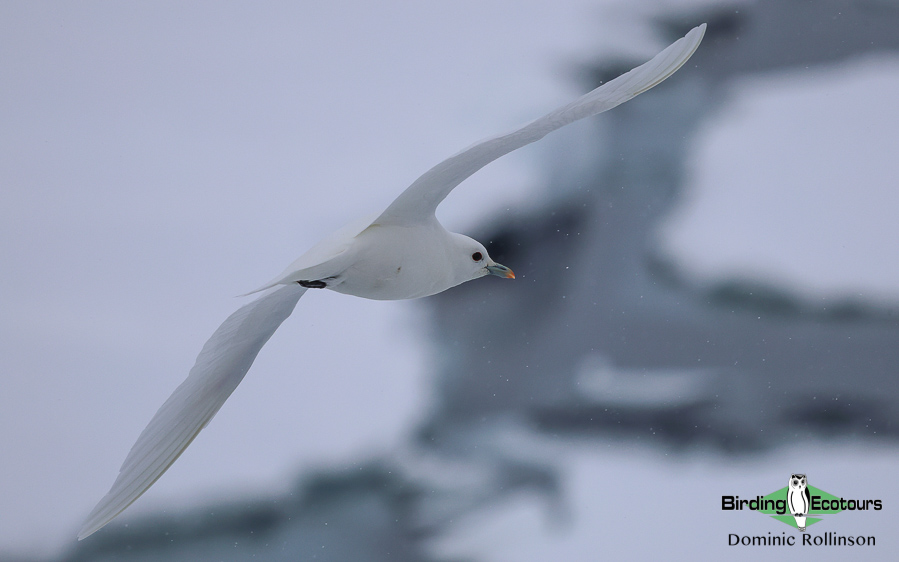
Ivory Gull is a high Arctic special that we had many great views of on this Arctic cruise.
Overview
Arctic birding and wildlife cruises offer the rare chance to explore a world that so few people ever get to experience. On these cruises we search for a small group of high Arctic bird and mammal species which can tolerate the harsh conditions of life in the Arctic Circle. Most people have likely heard of the large charismatic megafauna which occur in the Arctic such as Polar Bear, Walrus and Arctic Fox, and these are of course targeted (and usually found) on these cruises. However, there is also a suite a lesser-known birds and mammals which we look for too, such as Ivory Gull, King Eider, and Bearded Seal.
Just about all Arctic wildlife cruises depart from the town of Longyearbyen (hailed as the world’s most northerly settlement, with a population over 1,000 people) on Svalbard Archipelago’s largest island of Spitsbergen. Before the cruise departs, we usually do a morning or afternoon (or both) around town, where we can often get closer views of Red Phalarope, Red-throated Loon, King Eider, Rock Ptarmigan and Arctic Fox – which we normally see on our cruises but which tend to keep their distance. This trip was no different and we got excellent views of all our Longyearbyen targets, and got introduced to some of the area’s more common and widespread wildlife.

We hoped for closer views but nonetheless, it was amazing to enjoy extended views of this Polar Bear in the pack ice.
Of course, a cruise to the Arctic is generally focused on finding Polar Bear, the King of the Arctic, and although most cruises are successful, sightings are not guaranteed. Thankfully, on this year’s Arctic cruise we had good sightings of a single bear while up in the pack ice. Although our sighting was perhaps a little distant, we were able to watch it on and off for well over an hour and even watched it raising up onto its hind paws and crashing down with its front paws to try smash through the ice. With the aid of our spotting scope we could enjoy good extended views of this truly massive and charismatic predator. While up in the pack ice in the northwest of the Svalbard Archipelago we had fantastic repeat views of Ivory Gull, which is probably the most-wanted bird special on an Arctic wildlife cruise. While we were watching the Polar Bear, we even had a small group of Ivory Gulls come and land on the ice near our ship, further adding to the special moment. Other memorable sightings included great looks at Walrus (complete with an Ivory Gull on an ice floe), a small group of huge Blue Whales which showed really close to the ship for about an hour, and a few unexpected avian bonuses such as Iceland Gull, Tufted Duck and, most surprisingly, a very lost Western Yellow Wagtail – one just never knows what one might bump into!
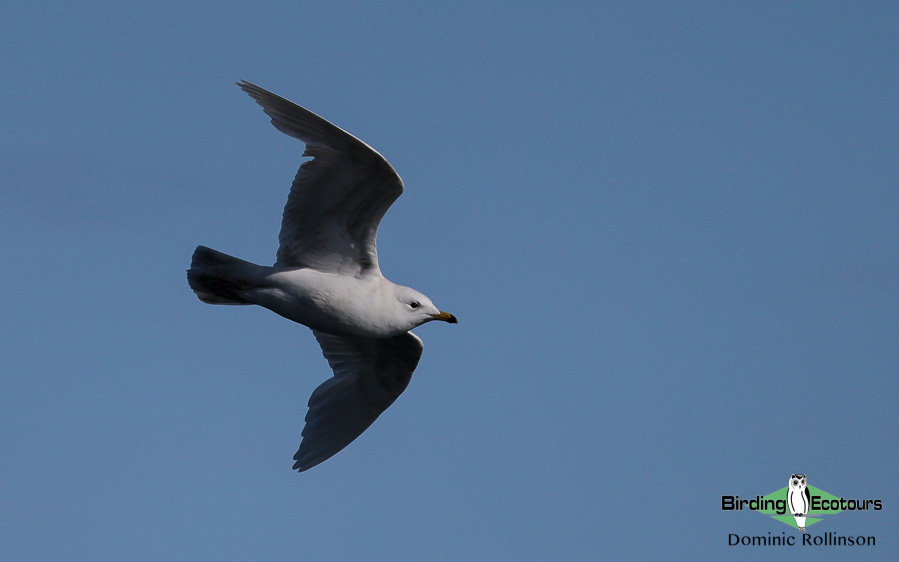
Iceland Gull which breeds in Canada and Greenland (not in Iceland), was a pleasant surprise at Poolepynten.
Weather in the Arctic can be a little unpredictable at times, however we were exceptionally lucky this time around, with perfect weather for just about every single day of the trip. On most days the sun was out and shining, which further aided photography in the land of the midnight sun. We had many perfectly still evenings, with glorious golden light which added to the enjoyment of the trip.
Detailed Report
Day 1, 31st May 2023. Arrival and Longyearbyen birding
Our Scandinavia Airlines flight landed around midday and headed into Longyearbyen, the most northerly town in the world. After checking in to our accommodation, we were soon back out the door and took a drive around town and some other nearby birding areas. Our first stop was at the husky kennels just east of town, where we enjoyed the large numbers of Common Eider, which are kept safe here because the huskies ensure Arctic Foxes are kept out of the area. We then made our way further east of town where we found Barnacle, Brant and Pink-footed Geese, and struck gold when we found an obliging female (females being the better looking of the sexes in phalaropes) Red Phalarope which was in fine breeding dress and did not seem at all perturbed by our presence. A nearby lake had a pair of Red-throated Loon as well as three Red-necked Phalarope, which are not quite as good-looking as Red Phalaropes, but nevertheless are very attractive species in their breeding colors. There were good numbers of Purple Sandpipers around too, with their high-pitched display call being a sound we would hear regularly over the next week.
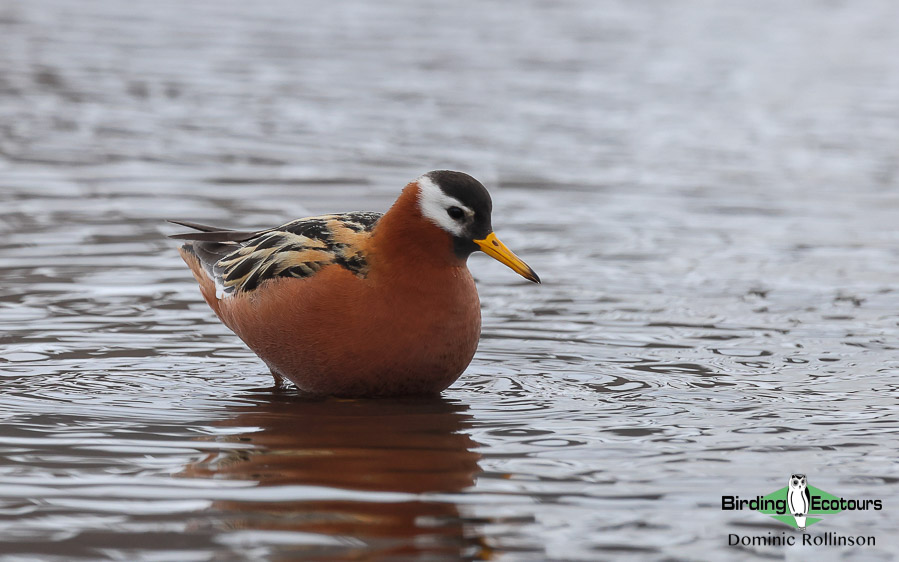
This female Red Phalarope was an early trip highlight.
The ponds below the airport produced a fantastic pair of King Eider, in amongst the many Common Eider. Further west of the airport, the cliffs were alive with singing Little Auks (Dovekies), and many Thick-billed Murres (Brünnich’s Guillemot), Northern Fulmars, Black-legged Kittiwakes and Glaucous Gulls seen flying out over the fjord. This area is normally a reliable site for feeding Arctic Foxes, but unfortunately there were none around this afternoon. We ended the day with burgers and beer in town, and excitedly discussed our Arctic birding and wildlife cruise which was to begin the following afternoon.
Day 2, 1st June 2023. Birding around Longyearbyen and boarding the Plancius
We were to board the Plancius late in the afternoon and therefore had most of the day to further enjoy the birding and wildlife around Longyearbyen. We began the day working some areas just above town frequented by Rock Ptarmigan, and it did not take long before a beautiful snow-white male performed its display flight above our heads. With this cruise taking place early in summer, it meant that many of the males were still in their immaculate white plumage and were a pleasure to observe. In this area we also watched a pair of Common Ringed Plovers which were in beautiful crisp breeding plumage and did not seem at all worried by our presence.
Heading west of the airport again, we saw most of the same bird species as yesterday afternoon, including a first-summer male King Eider, which was interesting to see, but the real highlight was when Karen spotted an Arctic Fox with another three animals seen in the area. The foxes were no longer in their pure white winter coats, with large patches of grey appearing throughout and perhaps looking a little scruffy. Interestingly, two of the animals had satellite collars, which are used to monitor their movements. On the cruise we learnt that satellite-tagged Arctic Foxes had been crossing from Svalbard all the way to Greenland and Canada! We stopped at the same pond (east of town) as yesterday afternoon, where the Red-throated Loons were again seen and, additionally, we found a male Tufted Duck (a scarce bird on Svalbard), as well as a fantastic pair of Long-tailed Ducks which flew in nearby and gave us really great views. A single female Red Phalarope was seen in the area too, but there was no sign of yesterday’s Red-necked Phalaropes. We ended our Longyearbyen birding with a walk down to the water’s edge, where we had close-up views of a pair of Parasitic Jaegers and our closest views of Brant Geese.
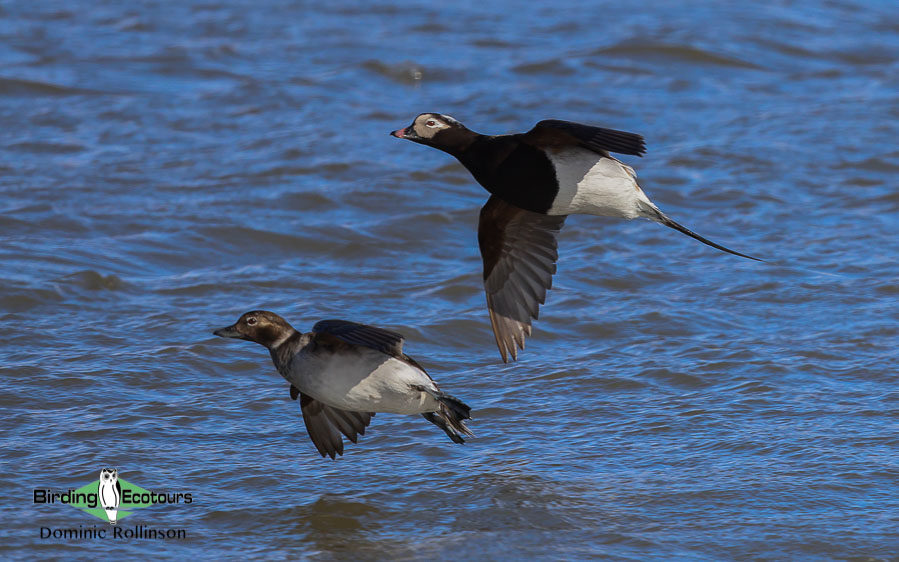
This pair of Long-tailed Ducks showed wonderfully well around Longyearbyen.
Later in the afternoon, after an enjoyable 24 hours around Longyearbyen, we boarded our vessel and slowly made our way out Ysfjorden in gorgeous weather. We were escorted out by Northern Fulmar which seemed to be enjoying themselves as they whizzed by at eye level, giving us superb views.
Day 3, 2nd June 2023. Birds and other wildlife of St Jonsfjord and Poolepynten
The weather was beautiful this morning and had, in fact, improved further since the previous evening, with hardly a breath of wind around. After breakfast we boarded zodiac boats and headed off for our first landing of the trip, at St Jonsfjord. We took a walk around the general area (where an old trapper’s hut still exists) and enjoyed some splendid scenery and weather. We had good views of a small group of Reindeer– of the endemic Svalbard subspecies – which are shorter legged than other Reindeer subspecies. The air was full of the sounds of Snow Buntings and Purple Sandpiper, and we were fortunate enough to spot several distant Bearded Seals sitting on the fast ice at the base of a glacier. We lifted anchor and en route to our next location we noticed some huge footprints on the mountainside, which could have only been made by one animal. Sadly, despite some concerted scanning with the telescope, we did not find any Polar Bears!
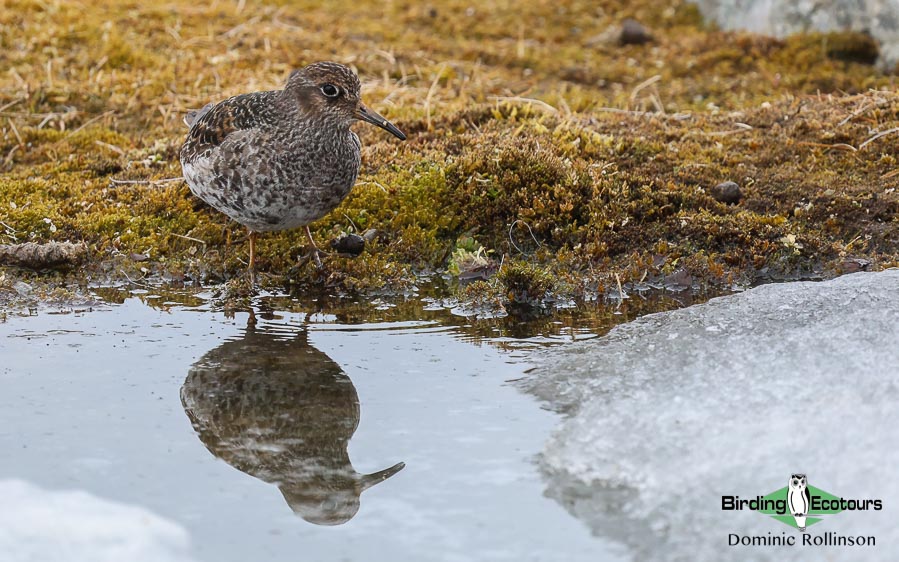
Attractive Purple Sandpipers were seen throughout our Arctic birding cruise.
The afternoon’s activity involved a visit to the pebble and sand beach at Poolepynten,where we observed an impressive Walrus haul-out. This area is a reliable place to observe these gigantic tusked seals, with all the animals seen here being males, as the females were away giving birth to their pups on floating ice. The setting was spectacular, with the Walruses in the foreground and ice-capped mountains in the background, with a sailboat passing by to add to the scene. While we were watching the large lump of Walruses, we noticed a gull that looked different from the many Glaucous Gulls around and quickly realized it was an Iceland Gull, which is a scarce bird in the Svalbard Archipelago and an unexpected bonus for the afternoon. Our walk back along the beach added another new trip bird in the form of a Ruddy Turnstone, which flew by noisily. Later that evening, as most of the passengers were getting ready for bed, the announcement came over the speaker system that there were whale blows off the bow. We all quickly got back into our outdoor clothes and enjoyed the spectacle from the bow. At least six Blue Whales were seen at varying distances, with a couple animals showing really close to the ship. Observing the largest animal to have ever lived was a perfect way to end the day!
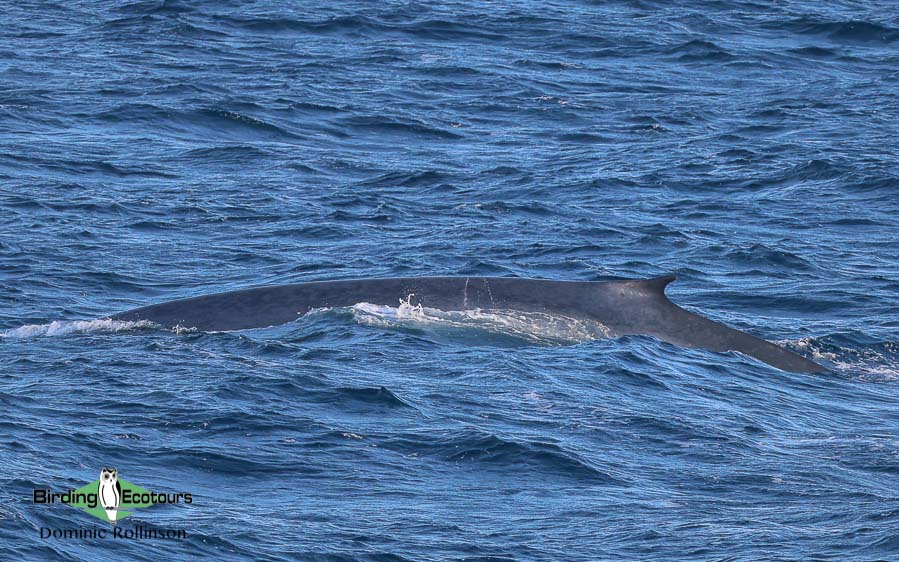
The dorsal fin of a Blue Whale, the largest animal to have ever lived!
Day 4, 3rd June 2023. 14 Julibukta and Lillehookbreen
We awoke to another beautiful morning in the Arctic and found ourselves in the beautiful 14 Julibukta (bukta being Norwegian for bay), with another impressive glacier on display nearby. After breakfast we set out on a zodiac cruise and enjoyed close views of the massive glacier, with large numbers of photogenic Black-legged Kittiwakes sitting on the ice floes. We then made our way towards the seabird cliffs, marveled at the masses of breeding kittiwakes overhead and enjoyed closer views of breeding Thick-billed Murres, Black Guillemots and our first Atlantic Puffins of the trip. It was then our turn to land at the stony beach, and we enjoyed walking slowly below the kittiwake cliffs (high up above) and were lucky enough to have close views of two Arctic Foxes (including one of the scarce dark-morph animals) which were busy searching for fallen eggs. We also had lovely views of a confiding Purple Sandpiper and brief views of several Snow Buntings.
In the afternoon we had a prolonged zodiac cruise of Lillehookbreen (breen is Norwegian for glacier) and marveled at the magnitude of the glacier which we cruised nearby to (but not too close to). There were good numbers of waterfowl seen amongst the ice floes, including dozens of King and Common Eiders and a small group of Long-tailed Ducks. A Red-throated Loon made a brief appearance as it flew by overhead. We enjoyed close views of Arctic Terns as they perched on floating ice, which made for some nice photographic opportunities. A Parasitic Jaeger was also seen perched on the ice, although this individual was not as accommodating as the terns!
Day 5, 4th June 2023. Into the pack ice and beyond 80o north!
Today was our first day navigating through the pack ice and we awoke to find the ship on the edge of the pack ice and soon after breakfast we crossed 80o north. The pack ice is generally the most reliable area to find Polar Bear and so we ensured we spent as much time as possible scanning with binoculars and telescopes for large cream-colored bears. Although today was not to be our day for bears, we almost immediately found our primary avian target, Ivory Gull, and we ended up finding 15 birds over the course of the day, with both adults and juveniles seen well. There was an obvious lack of large megafauna seen today (with only Harp Seal positively identified), however there were large numbers of birds around, including Black-legged Kittiwake (hunting for fish as we broke through the ice), Glaucous Gull, Thick-billed Murre, Black Guillemot, Little Auk, and surprisingly Ruddy Turnstone and Snow Bunting. Despite not seeing any Polar Bears today, it was a thoroughly enjoyable day in this unique environment that so few people ever experience. That evening we enjoyed a barbecue out on deck, which was good fun and a nice way to end our first day in the pack ice.
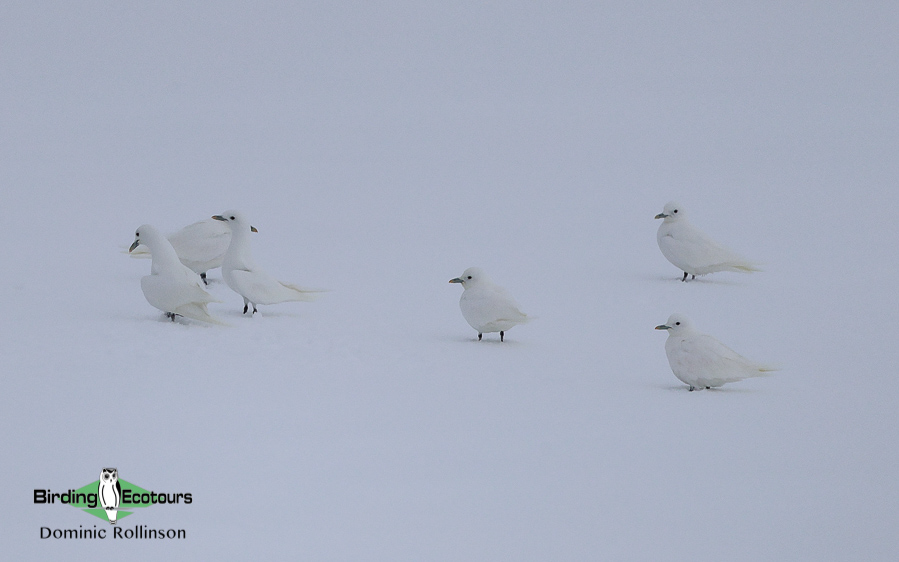
Ivory Gulls were numerous in the pack ice of northwestern Svalbard.
Day 6, 5th June 2023. More time in the pack ice
The day could not have got off to a better start when at around 06h30 the call came through on the speaker system that a Polar Bear had been spotted from the bridge and that we were slowly edging towards it. We all rushed outside and although the Polar Bear was some distance away, we eventually had good views as the ship was able to move relatively close to it. We enjoyed watching the bear, which seemed completely unfazed by the ship being nearby, and it even took a ten-minute nap. The bear then headed away from our vessel and kept getting further from us. We tried to get close views but it unfortunately chose an area where our ship was unable to access (due to thick pack ice) and so we decided to keep moving through the pack ice and see what else we could find. Another highlight while we enjoyed the bear, was a group of Ivory Gulls which perched on the ice right next to the vessel and showed very well for us. Today proved much more productive than yesterday and we encountered large numbers of seals of a variety of species (likely the reason the bear was in the area). The large Bearded Seal showed well for us with some animals seen quite close to the vessel, where we could see their long whiskers, giving them quite a comical look. Harp Seals were seen regularly, mostly just brief views of swimming animals, until a fantastic male showed wonderfully well for us on an ice floe. Ringed Seals were also commonly encountered, however these animals were always at some distance away and were best enjoyed through the telescope. Unlike Harp and Bearded Seals, Ringed Seals were often seen well away from the ice edge as they tunnel holes through the ice, to escape from predatory Polar Bears. A Walrus posed for us on an ice floe in the late afternoon, complete with an Ivory Gull next to it to complete the picture – it really was a beautiful and peaceful scene!
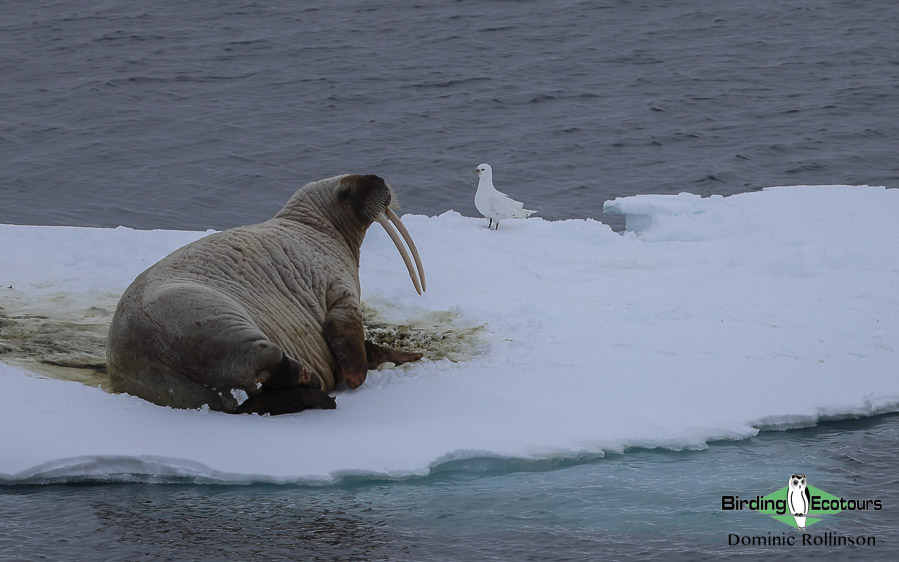
Walrus and Ivory Gull, two iconic high Arctic species.
There were again large numbers of birds around all day long, with Ivory Gulls seen on and off, as well as large numbers of Thick-billed Murres, Black Guillemots, Little Auks and Atlantic Puffins seen. We even had a new trip bird in the form of a single Great Skua which flew overhead.
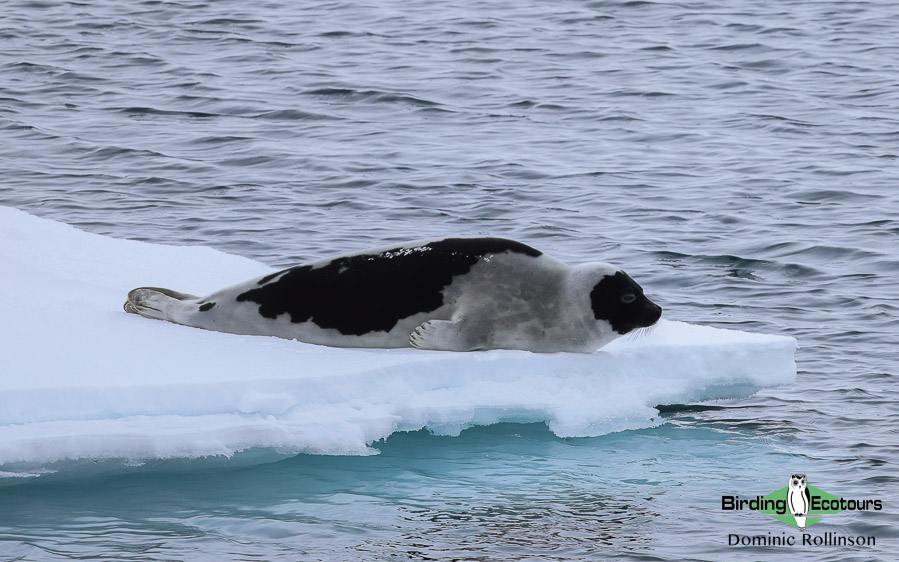
This male Harp Seal showed incredibly well for us on the pack ice.
Day 7, 6th June 2023. Ytre Norskoya and Fuglelsongen
We awoke to perhaps the most beautiful morning of the trip, with blue skies and windless conditions, and boarded the zodiacs for a landing on Ytre Norskoya (ytre meaning island in Norwegian). We enjoyed a good walk through the thick snow and saw both Barnacle and Pink-footed Geese for the first time in a few days. There were also several pairs of Snow Buntings around which kept us entertained, however the highlight of the morning, and probably our most unexpected tick of the trip, was a male Western Yellow Wagtail (of the Scandanavian thunbergi subspecies) which showed briefly for us and seemed very out of place here. Western Yellow Wagtails are rare vagrants to the Svalbard Archipelago with just a few previous records.
Our afternoon’s activities involved a landing at Fuglelsongen (meaning bird song), which was alive with the sounds of singing Little Auks, and we enjoyed watching and photographing these little alcids as they went about looking for suitable mates, and we even saw some pairs mating. After watching the auks, we went for a zodiac cruise around the fjord, and although it was a little quiet, we did enjoy close views of a confiding Atlantic Puffin, a pair of Parasitic Jaegers harassing a Black-legged Kittiwake, and a Harbour Seal on the ice. That evening during dinner we glanced out of the window and spotted a few Walruses out swimming, which is always a sight to see while enjoying dinner.
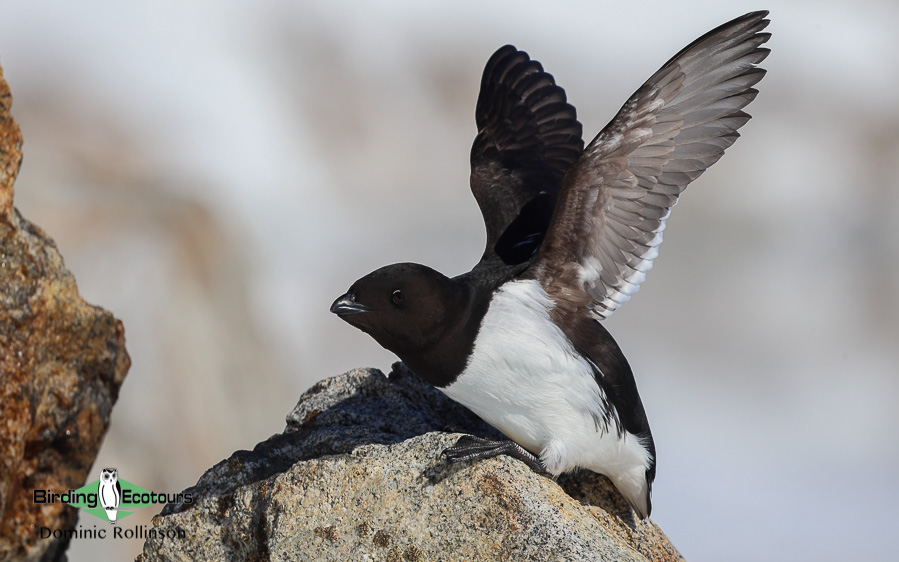
Visiting the Little Auk colony at Fuglelsongen was certainly one of the trip’s (many) highlights.
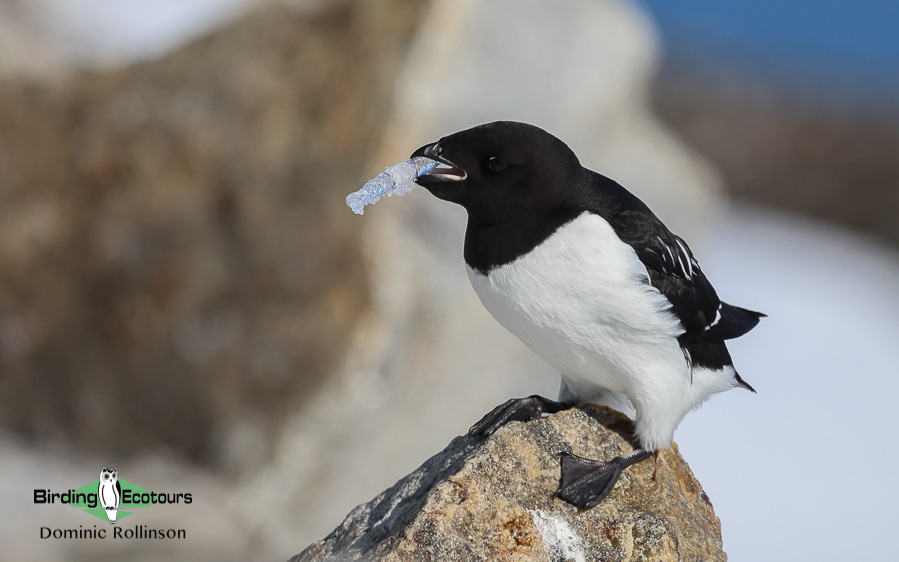
This Little Auk seemed rather proud of this icicle that it had found.
Day 8, 7th June 2023. Tordenskjoldbukta and Alkhornet
The weather was yet again on our side this morning and after breakfast we headed out on zodiacs for our landing at Tordenskjoldbukta. This morning’s landing mostly involved a gentle walk across the tundra and was very birdy and most enjoyable. The large open pebble beach had both Purple Sandpipers and Common Ringed Plovers as we landed, and we soon spotted a single Great Black-backed Gull in amongst the many Glaucous Gulls. We watched a small group of Arctic Terns as they fed in the bay and then had a Great Skua flying overhead. On our walk we enjoyed watching the many Reindeer out on the tundra and found a few shed sets of antlers. A final scan out over the pebble beach revealed a small group of Brant Geese as well as three Red Phalaropes bobbing around on the edge of the shore. As we were boarding our zodiac to head back to the ship, we spotted a beautiful breeding plumage Sanderling, which was our first sighting of the trip. Our final afternoon of the cruise involved a landing at the impressive Alkhornet, which is a 428-meter-high mountain with huge numbers of breeding seabirds high up on the cliffs above. We enjoyed watching and listening to the masses of Black-legged Kittiwakes and Thick-billed Murres as they came and went, and even watched some marauding Glaucous Gulls as they brutally picked off a couple kittiwakes which had wandered away from the safety of the flock. There were also good numbers of Snow Buntings around, which posed nicely for photos. It was a perfectly still afternoon with gorgeous views out over the surrounding fjords and, before we headed back to our ship, we watched as a few brave souls took a polar plunge in the icy waters.
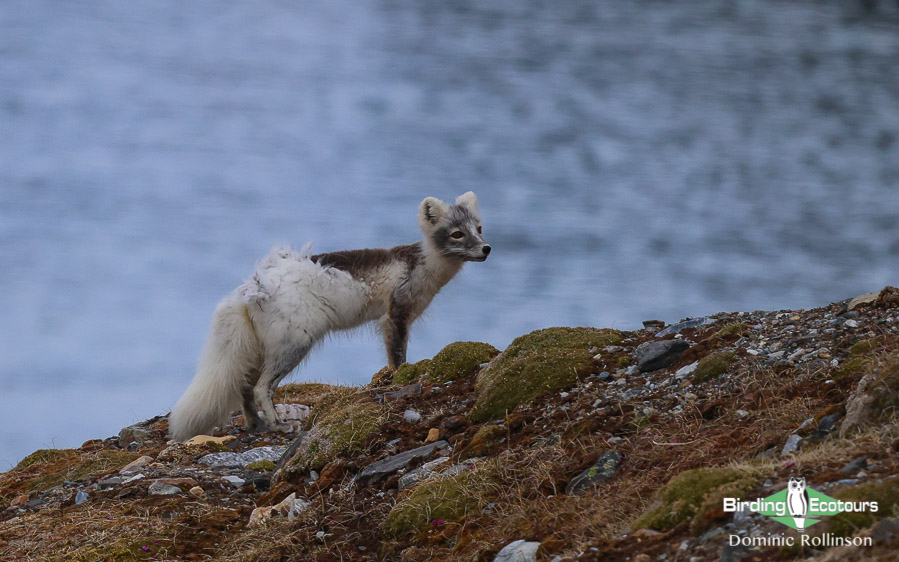
Arctic Fox were frequently encountered on our cruise.
Day 9, 8th June 2023. Departure from Longyearbyen After a fantastic and highly successful week-long Arctic cruise, we headed back into Longyearbyen before our early afternoon flights back home. We had some time to kill before our flights and took a walk around town where we enjoyed further looks at Parasitic Jaeger, Common Eider, Purple Sandpiper and Snow Bunting. Thank you, Karen and Wendy, for all the good laughs and fun memories.
Bird List – Following IOC (12.3)
The following notation after species names is used to show conservation status following BirdLife International: VU = Vulnerable.
| Common Name | Scientific Name |
| Ducks, Geese, Swans (Anatidae) | |
| Brant Goose | Branta bernicla |
| Barnacle Goose | Branta leucopsis |
| Pink-footed Goose | Anser brachyrhynchus |
| King Eider | Somateria spectabilis |
| Common Eider | Somateria mollissima |
| Tufted Duck | Aythya fuligula |
| Long-tailed Duck – VU | Clangula hyemalis |
| Pheasants & Allies (Phasianidae) | |
| Rock Ptarmigan | Lagopus muta |
| Plovers (Charadriidae) | |
| Common Ringed Plover | Charadrius hiaticula |
| Sandpipers, Snipes (Scolopacidae) | |
| Ruddy Turnstone | Arenaria interpres |
| Purple Sandpiper | Calidris maritima |
| Dunlin | Calidris alpina |
| Sanderling | Calidris alba |
| Red Phalarope | Phalaropus fulicarius |
| Red-necked Phalarope | Phalaropus lobatus |
| Gulls, Terns, Skimmers (Laridae) | |
| Black-legged Kittiwake – VU | Rissa tridactyla |
| Ivory Gull | Pagophila eburnea |
| Great Black-backed Gull | Larus marinus |
| Glaucous Gull | Larus hyperboreus |
| Iceland Gull | Larus glaucoides |
| Arctic Tern | Sterna paradisaea |
| Skuas (Stercorariidae) | |
| Great Skua | Stercorarius skua |
| Parasitic Jaeger | Stercorarius parasiticus |
| Auks (Alcidae) | |
| Little Auk | Alle alle |
| Thick-billed Murre | Uria lomvia |
| Black Guillemot | Cepphus grylle |
| Atlantic Puffin – VU | Fratercula arctica |
| Loons (Gaviidae) | |
| Red-throated Loon | Gavia stellata |
| Petrels, Shearwaters, Diving Petrels (Procellariidae) | |
| Northern Fulmar | Fulmarus glacialis |
| Wagtails, Pipits (Motacillidae) | |
| Western Yellow Wagtail | Motacilla flava |
| Longspurs, Snow Buntings (Calcariidae) | |
| Snow Bunting | Plectrophenax nivalis |
| Species Seen | 31 |
Mammal List
The following notation after species names is used to show conservation status following IUCN Red List: EN = Endangered, VU = Vulnerable.
| Common Name | Scientific Name |
| Rorquals (Balaenopteridae) | |
| Common Minke Whale | Balaenoptera acutorostrata |
| Blue Whale – EN | Balaenoptera musculus |
| Dog-like mammals (Canidae) | |
| Arctic Fox | Vulpes lagopus |
| Walruses (Odobenidae) | |
| Walrus – VU | Odobenus rosmarus |
| True seals (Phocidae) | |
| Bearded Seal | Erignathus barbatus |
| Harp Seal | Pagophilus groenlandicus |
| Ringed Seal | Pusa hispida |
| Harbor Seal | Phoca vitulina |
| Deer (Cervidae) | |
| (Svalbard) Reindeer (Caribou) – VU | Rangifur tarandus platyrhynchus |
| Species Seen | 10 |
This is a sample trip report. Please email us ([email protected]) for more trip reports from this destination.